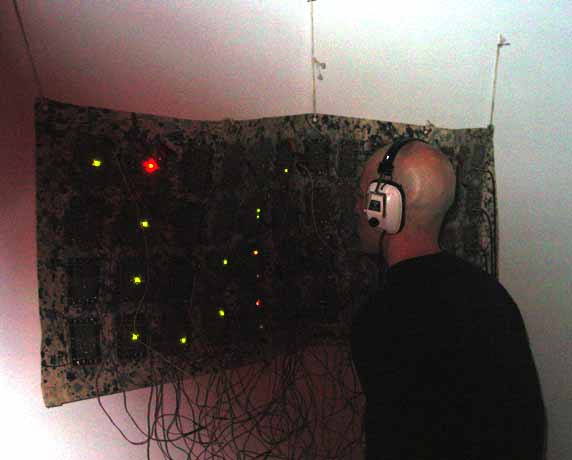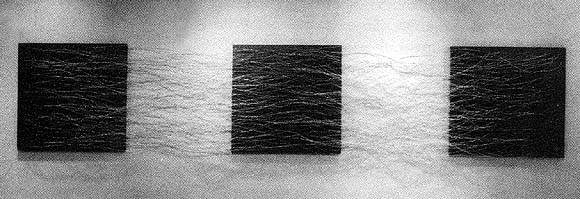
View current page
...more recent posts
I'm trying to set up a music studio and it's slow and frustrating as hell. There's a reason I use simple-minded programs in my visual work--I want the tech to be fast and uncomplicated, and then I compensate by doing something ridiculously labor-intensive on the physical end. So far I've had a similar approach to music, somewhat in reverse: using entry level programs and the computer's sound card but mousing in the entire composition note by note on an old fashioned staff. One of my family members said, "Yeah, but it's the same four notes over and over!" I tried to explain that there are timbral variations that make the work similar to my sphere paintings, which this person likes, and exciting octave jumps, and subtle things with syncopation, and...well.
The problem is I'm tired of the textures of the low end music programs and want the sound to get richer. I love the Sidstation synthesizer I bought recently and think it deserves better accompaniment than the sound card synths in the shareware program I downloaded. I'm tired of buzz and hum in the recording. I want better bass and drum sounds. I want a real sequencer.
Before Christmas I bought a sampler from craigslist: an E-mu E6400 Classic. I've been playing with it tonight and it's been fun learning how a 9 year old sampler works but, actually, I'm not sure it does work. I managed to record a 1-second sample but couldn't save it. This machine has no internal hard drive, so my options are to hook a scuzzy (SCSI) cable up to a zip drive or CD ROM, neither of which I have, get an adapter card and enter "Scuzzy Hell" trying to get my PC to read it, or use the floppy drive to store small bits of data. Watching this thing slo-o-owly format a floppy was discouraging, and then I couldn't save to it. After 3 tries I successfully named a "bank," but then the sample wouldn't go in it. Eventually I turned off the machine and lost the sample.
The State of the Art?
To catch and keep the ear of your audience, you need to be able to deliver new sounds. Just watch TV for a few minutes. Listen to the sounds used in commercials, on movies and even on top40 radio. Listen to a few cuts from the top albums. You hear sounds that are fresh, new and intriguing everywhere. It's now the norm to mangle drum beats, come up with what used to be considered bizarre synth sounds. As we entered the 21st century, Noise and retro synth sounds have taken a new hold on the contemporary musical consciousness. Spacey, trippy, grungy, quirky, 'retro' synthy sounds are "cool". It used to be that industrial noise and industrial ambient sounds were radical, and cutting edge. Now they are practically mainstream, and you have to have them just to fit in. But now we are rapidly running past DnB, club, techno Hard Core, Gabber and are contemporizing and mainstreaming these sounds with both retro and vintage sounds, and with the beautiful sonorities of new age and world music. I call this homogenization Post-Industrial Sound. "Post" means "after", or the sounds that are the metamorphosis of these as we leave 20th century industrial music.--manifesto/ad copy for Rich the Tweakmeister's Post-Industrial Cybr-Sound Depot
My goal was to create a massive 128 meg palette of sounds for the Emulator EOS series that would have everything I need to make any synthesized color I want, from the dirtiest analog mix cutting drone to the tiniest arpeggiator ready crystalline little blip. And everything in between. There is a tremendous variation of useful vintage sounding synths and leads, steamy pads dripping with character, unusual Orch hits, a vast range of electronica-oriented synth basses, and finally hundreds of variations of noise. All of these are combined in EOS to make killer synths and pads, drum machines you have never heard before. The true joy of a great soundset is that possibilities open. You can simply link 2 or more presets together and come up with something totally new. But not everything on this disk is new. There's some stuff that really old, like tons of variations of synth strings, new agey pads made on analog, raw clean CZ violins, stock basses in addition to hot ones, clean PCM sample-playback tones. Sample playback? The Horror! Ease back, my filter swept friend, think as a sonic artist, a dab of this, a dab of that and a unique color comes to life. And fear not, the TweakMeister adds filters and real time controllers to everything. Expect to turn a knob and have something cool happen. This is not a genre specific soundset. We are post-industrial, after the metamorphosis. Expect new and old blended, morphed, transformed. Expect the bright and thin with the phatt and lush.
New track: "Taser Squad" [mp3 removed].
Dark, gloomy, bare-bones techno where the bolts pop off the synthesizer and the circuits audibly fail.
My complete musical works in .mp3 form are here (19 tracks since 1998!)

More on the circuit bending genre. The painterly and/or sculptural aspirations of benders can be problematic, especially if the result is sci fi cliche, but the physical aspect can be engaging, too. So we're looking for good examples of circuit bent pieces that are visually, musically, performatively tight. I've posted work by Peter Blasser (aka Peter B) before; above is another piece of his (I think it's his) that I photographed at the Shinth Tour at Deitch last year. It reminds me of Eva Hesse's Metronomic Irregularity II (below) only with a sound component: actually it's as if her work looked forward to a time when sound would complete the idea.

My memories of the Blasser piece are sketchy. I don't know what the circuit board/sound-producing module thingies are. The cloth is a paint-spattered rectangle of canvas that's like a parody of a bad Pollock, but the expressionism component is relevant, particularly in light of the Hesse, which has been described as an attempt to reconstitute Pollock in the vocabulary of '60s minimalism. The sound you hear through the headphones is the sublime product of random crisscrossing connections in the circuit field: chirping robotic crickets, but with pauses and subtleties making them slightly haunted and Eno-esque. The blinking lights were their ephemeral, firefly-droid cousins. I don't know if there was any programming involved in the routing of the signals, or if it was solely a product of hardwiring parts. I guess I don't really care. More detail about the piece would be appreciated.
UPDATE: via cory, a momus-sponsored page devoted to Peter Blasser's old band the Gongs. the mp3 doesn't work but great photo. also link to CD (don't know about availability).
Loop Collection Updated.
Techno Loop
Proto-Trance Loop
Psychedelic Rock Loop
![]() P0rn Loop
P0rn Loop
Update, 2013: Have been removing older mp3 links -- sadly these loops had to go. Trust me, this post was funnier before it became a graveyard.
New track: "Kill Maurice" [mp3 removed]. I made a video to go with this but I think I'll hold off on posting it. The molecular imagery seems too zany for this music. I learned a lot about editing, and sync-ing sound to images, but I'm starting to think I really hate video. It sucks your attention and demands more, more, more to a much greater extent than music, still imagery, or even looped .GIFs--it's an almost bottomless pit of (diminishing) content. There's a reason Billy Grant's rapidfire, overloaded videos are the way they are--it's what the medium has conditioned our eyes to expect. I've made three short vids now and dislike them not as videos, but philosophically, in that they seem to be trying to play the same game. Maybe I just haven't found the right fit between the music I'm writing and the imagery. But I also hate most MTV and it's hard to find a way around that model.